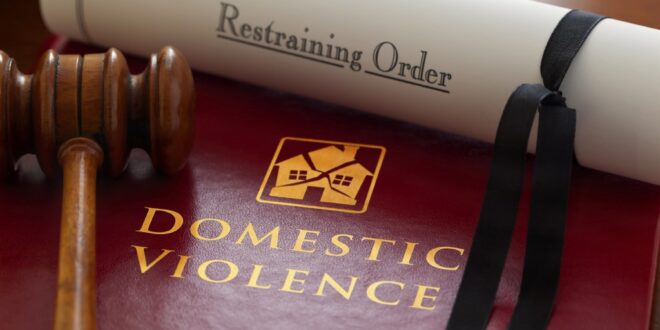Did you know that 1 in 3 women and 1 in 4 men experience severe intimate partner violence, including physical violence, sexual violence, and/or stalking? It’s a shocking statistic, but one that underscores the importance of knowing what a restraining order is and how it can help protect you and your loved ones from domestic violence.
In this article, we’ll be discussing the ins and outs of a domestic violence restraining order, also known as a DVRO. Whether you’re experiencing domestic violence firsthand or know someone who is, it’s important to understand what options are available to help keep you safe.
So, what is a restraining order, and how can it provide the protection you need? Read on to find out.
Table of Contents
Definition of a Domestic Violence Restraining Order

Domestic violence is a serious and pervasive problem in our society, affecting people of all ages, genders, and backgrounds. If you or someone you know is experiencing domestic violence, it’s important to understand what a domestic violence restraining order, or DVRO, is and how it can help.
A DVRO is a legal order issued by a court that requires an individual who has been found to have committed acts of domestic violence to stay away from the victim and their family members. It can also require the individual to move out of the home they share with the victim, relinquish firearms, and pay child support or spousal support.
The types of behavior that can constitute domestic violence are broad and can include:
- Physical abuse
- Emotional abuse
- Sexual abuse
- Financial abuse
These behaviors can be subtle or overt and can happen in any type of relationship.
Obtaining a DVRO can be a crucial step in protecting yourself and your family from further harm. It can provide a legal barrier between you and the abuser, giving you time and space to make decisions about your safety and well-being.
However, it’s important to note that a DVRO is not a guarantee of safety. It may be necessary to take additional steps to protect yourself, such as changing your phone number or moving to a safe location.
If you or someone you know is experiencing domestic violence, don’t hesitate to seek help. Contact a domestic violence hotline or speak to an attorney to learn more about your options for protecting yourself and your family.
Who Can Get a Domestic Violence Restraining Order?

If you or someone you know is experiencing domestic violence, it’s important to know that help is available. One way to protect yourself from an abusive partner or family member is by obtaining a DVRO.
But who is eligible to apply for a DVRO? In general, anyone who is a victim of domestic violence can seek a restraining order. This includes current or former spouses, cohabitants, domestic partners, and even individuals who are simply dating or have dated in the past.
However, it’s important to note that DVROs may not be appropriate in all situations. For example, if the person who is causing harm is not a family member or intimate partner, a personal protection order (PPO) may be more appropriate.
A PPO is similar to a DVRO in that it provides legal protection against harassment, stalking, or other forms of violence. However, it may apply to a wider range of situations than a DVRO, such as in cases of workplace harassment or stalking by a stranger.
In either case, obtaining a restraining order can be a complex process. It may involve filing paperwork with the court, attending a hearing, and providing evidence of the abuse or harassment you have experienced. However, with the help of an experienced attorney, you can take steps to protect yourself and your loved ones from further harm.
How to Get a Domestic Violence Restraining Order

If you or someone you know is experiencing domestic violence, it’s important to take action to protect yourself and your loved ones. One option for doing so is to obtain a domestic violence restraining order.
To get a DVRO, you will typically need to follow these steps:
Step 1
Contact an attorney or a domestic violence hotline for help. They can provide you with guidance on how to proceed and connect you with resources in your area.
Step 2
File a restraining order with the court. You will typically need to provide information about yourself, the person you are seeking protection from, and the reasons why you are seeking a DVRO.
Step 3
Attend a hearing. You may be required to appear in court to provide additional information about your situation and why a DVRO is necessary.
Step 4
Serve the person you are seeking protection from. Once the DVRO has been granted, it will need to be served on the individual named in the order.
If you are unsure about how to proceed, speak to an attorney or a domestic violence hotline for guidance. They can help you understand your options and provide you with the support you need to protect yourself and your family.
What a Domestic Violence Restraining Order Does

A DVRO is a legal order that can provide critical protection for victims of domestic violence. It is a powerful tool that can help you and your family stay safe from further harm.
A DVRO can do several things, including:
- Prohibit the abuser from contacting you
- Prohibit the abuser from coming near you
- Require the abuser to move out of your home
- Prohibit the abuser from possessing firearms
- Require the abuser to pay child support or spousal support
It’s important to note that a DVRO is not a guarantee of safety. You may still need to take additional steps to protect yourself, such as changing your phone number or moving to a safe location. Additionally, in some cases, a personal protection order (PPO) may be more appropriate.
Violating a Domestic Violence Restraining Order
Violating a domestic violence restraining order can have serious consequences. If the abuser violates the order, they can be arrested and charged with a crime. This can result in fines, probation, or even jail time.
It’s important to remember that a DVRO is a court order, not just a piece of paper. If the abuser violates the order, it is important to take it seriously and report the violation to the authorities. Additionally, if you feel that you are in immediate danger, call 911 or your local police department.
Protect Yourself and Your Loved Ones with a Domestic Violence Restraining Order
A domestic violence restraining order can provide you with the protection and peace of mind you need to live your life without fear. If you are experiencing domestic violence, it is important to know that you are not alone and that there is help available.
Head to our Health section for additional resources and information. Remember, you have the right to live a life free from domestic violence, and there are resources available to help you.
 World Magazine 2024
World Magazine 2024






